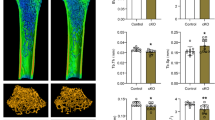Abstract
As a traditional concept of Chinese medicine (CM), the theory of “Shen (Kidney) controlling bones” has been gradually proven. And in modern allopathic medicine, the multiple mechanisms of bone growth, development and regeneration align with the theory. Shen deficiency as a pathological condition has a negative effect on the skeleton of body, specifically the disorder of bone homeostasis. Present studies indicate that Shen deficiency shares a common disorder characterized by dysfunction of hypothalamic-pituitary-adrenal (HPA) axis. HPA axis may be an important regulator of bone diseases with abnormal homeostasis. Therefore, we posit the existence of hypothalamic-pituitary-adrenal-osteo-related cells axis: cells that comprise bone tissue (osteo-related cells) are targets under the regulation of HPA axis in disorder of bone homeostasis. Chinese herbs for nourishing Shen have potential in the development of treatments for disorder of bone homeostasis.
Similar content being viewed by others
References
Malenka RC, Nestler EJ, Hyman SE eds. Neural and neuroendocrine control of the internal milieu. In: Molecular neuropharmacology: a foundation for clinical neuroscience. 2nd ed. New York: McGraw-Hill Medical, 246:248–259.
Ensrud KE, Crandall CJ. Osteoporosis. Ann Intern Med 2017;167:ITC17–ITC32.
Rachner TD, Khosla S, Hofbauer LC. Osteoporosis: now and the future. Lancet 2011;377:1276–1287.
Aloumanis K, Mavroudis K. The "depressive" face of osteoporosis and the "osteoporotic" face of depression. Hormones (Athens) 2013;12:350–362.
Sasanuma H, Nakata M, Parmila K, Nakae J, Yada T. PDK1-FoxO1 pathway in AgRP neurons of arcuate nucleus promotes bone formation via GHRH-GH-IGF1 axis. Mol Metab 2017;6:428–439.
Manolagas SC, O’Brien CA, Almeida M. The role of estrogen and androgen receptors in bone health and disease. Nat Rev Endocrinol 2013;9:699–712.
Onal M, Xiong J, Chen X, Thostenson JD, Almeida M, Manolagas SC, et al. Receptor activator of nuclear factor kappaB ligand (RANKL) protein expression by B lymphocytes contributes to ovariectomy-induced bone loss. J Biol Chem 2012;287:29851–29860.
Martin-Millan M, Almeida M, Ambrogini E, Han L, Zhao H, Weinstein RS, et al. The estrogen receptor-alpha in osteoclasts mediates the protective effects of estrogens on cancellous but not cortical bone. Mol Endocrinol 2010;24:323–334.
Koh JM, Khang YH, Jung CH, Bae S, Kim DJ, Chung YE, et al. Higher circulating hsCRP levels are associated with lower bone mineral density in healthy pre-and postmenopausal women: evidence for a link between systemic inflammation and osteoporosis. Osteoporos Int 2005;16:1263–1271.
Jurado S, Garcia-Giralt N, Diez-Perez A, Esbrit P, Yoskovitz G, Agueda L, et al. Effect of IL-1beta, PGE(2), and TGF-beta1 on the expression of OPG and RANKL in normal and osteoporotic primary human osteoblasts. J Cell Biochem 2010;110:304–310.
Eades LE, Thiagarajah AS, Harris J, Jones SA, Morand EF, Leech M. GILZ: a new link between the hypothalamic pituitary adrenal axis and rheumatoid arthritis? Immunol Cell Biol 2014;92:747–751.
Beishuizen A, Thijs LG. Endotoxin and the hypothalamopituitary-adrenal (HPA) axis. J Endotoxin Res 2003;9:3–24.
Silverman MN, Miller AH, Biron CA, Pearce BD. Characterization of an interleukin-6-and adrenocorticotropindependent, immune-to-adrenal pathway during viral infection. Endocrinology 2004;145:3580–3589.
Pace TW, Miller AH. Cytokines and glucocorticoid receptor signaling. Relevance to major depression. Ann N Y Acad Sci 2009;1179:86–105.
Ren YB, Huang JH, Cai WJ, Shen ZY. Shen-Jing as a Chinese medicine concept might be a counterpart of stem cells in regenerative medicine. Chin J Integr Med 2015 Jul 4. Epub ahead print.
Pierce H, Zhang D, Magnon C, Lucas D, Christin JR, Huggins M, et al. Cholinergic signals from the CNS regulate G-CSF-mdiated HSC mobilization from bone marrow via a glucocorticoid signaling relay. Cell Stem Cell 2017;20:648–658, e644.
Evans JF, Ragolia L. Systemic and local ACTH produced during inflammatory states promotes osteochondrogenic mesenchymal cell differentiation contributing to the pathologic progression of calcified atherosclerosis. Med Hypotheses 2012;79:823–826.
Isales CM, Zaidi M, Blair HC. ACTH is a novel regulator of bone mass. Ann N Y Acad Sci 2010;1192:110–116.
Author information
Authors and Affiliations
Corresponding author
Additional information
Supported by the Major Science and Technology Special Project of Zhejiang Province to TONG Pei-jian (No. 2014C03035), the Zhejiang Provincial Major Science and Technology Project of Medical and Health of China to TONG Pei-jian (No. 201487674), and Cultivation Program for Innovative Talent Graduate Students to XU Tao-tao (No. 311100G00901) from Zhejiang Chinese Medical University
Rights and permissions
About this article
Cite this article
Xu, Tt., Jin, Ht. & Tong, Pj. Essence of “Shen (Kidney) Controlling Bones”: Conceptual Analysis Based on Hypothalamic-Pituitary-Adrenal-Osteo-Related Cells Axis. Chin. J. Integr. Med. 24, 806–808 (2018). https://doi.org/10.1007/s11655-018-2930-x
Accepted:
Published:
Issue Date:
DOI: https://doi.org/10.1007/s11655-018-2930-x




